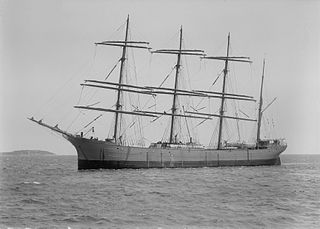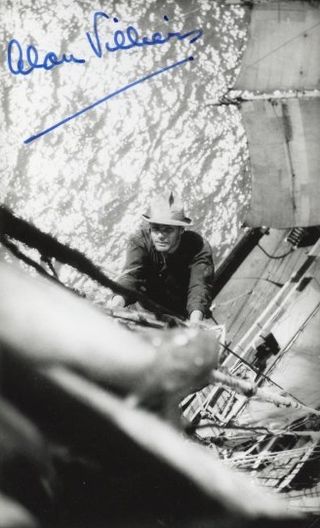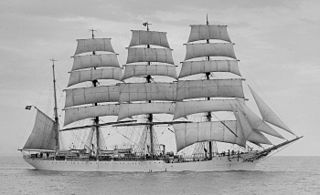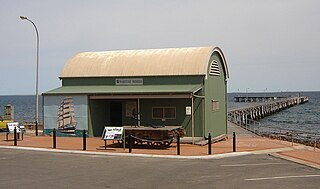
Pamir was a four-masted barque built for the German shipping company F. Laeisz. One of their famous Flying P-Liners, she was the last commercial sailing ship to round Cape Horn, in 1949. By 1957, she had been outmoded by modern bulk carriers and could not operate at a profit. Her shipping consortium's inability to finance much-needed repairs or to recruit sufficient sail-trained officers caused severe technical difficulties. On 21 September 1957, she was caught in Hurricane Carrie and sank off the Azores, with only six survivors rescued after an extensive search.

From its modern interpretations to its antecedents when maritime nations would send young naval officer candidates to sea, sail training provides an unconventional and effective way of building many useful skills on and off the water.

Lawhill was a steel-hulled four-masted barque rigged in "jubilee" or "baldheaded" fashion, i.e. without royal sails over the top-gallant sails, active in the early part of the 20th century. Although her career was not especially remarkable, save perhaps for being consistently profitable as a cargo carrier, in the 1930s Richard Cookson went on board and extensively documented Lawhill's internals and construction, which was later published in the Anatomy of the Ship series.

Iron-hulled sailing ships represented the final evolution of sailing ships at the end of the age of sail. They were built to carry bulk cargo for long distances in the nineteenth and early twentieth centuries. They were the largest of merchant sailing ships, with three to five masts and square sails, as well as other sail plans. They carried lumber, guano, grain or ore between continents. Later examples had steel hulls. They are sometimes referred to as "windjammers" or "tall ships". Several survive, variously operating as school ships, museum ships, restaurant ships, and cruise ships.

স is a German four-masted steel barque and one of the Flying P-Liners, the famous sailing ships of the German shipping company F. Laeisz. She is one of the last surviving windjammers.

Pommern, formerly Mneme (1903–1908), is an iron-hulled sailing ship. It is a four-masted barque that was built in 1903 at the J. Reid & Co shipyard in Glasgow, Scotland.

Alan John Villiers, DSC was a writer, adventurer, photographer and mariner.

Moshulu is a four-masted steel barque, built as Kurt by William Hamilton and Company at Port Glasgow in Scotland in 1904. The largest remaining original windjammer, she is currently a floating restaurant docked in Penn's Landing, Philadelphia, adjacent to the museum ships USS Olympia and USS Becuna.

Viking is a four-masted steel barque, built in 1906 by Burmeister & Wain in Copenhagen, Denmark. She is reported to be the biggest sailing ship ever built in Scandinavia. In the 21st century her sailing days have drawn to a close, and she is now moored as a botel in Gothenburg, Sweden.

The clipper route was derived from the Brouwer Route and was sailed by clipper ships between Europe and the Far East, Australia and New Zealand. The route, devised by the Dutch navigator Hendrik Brouwer in 1611, reduced the time of a voyage between The Netherlands and Java, in the Dutch East Indies, from almost 12 months to about six months, compared to the previous Arab and Portuguese monsoon route.

Cape Horn is the southernmost headland of the Tierra del Fuego archipelago of southern Chile, and is located on the small Hornos Island. Although not the most southerly point of South America, Cape Horn marks the northern boundary of the Drake Passage and marks where the Atlantic and Pacific Oceans meet.

The Last Grain Race is a 1956 book by Eric Newby, a travel writer, about his time spent on the four-masted steel barque Moshulu during the vessel's last voyage in the Australian grain trade.

Port Rickaby is a town on the Spencer Gulf coast of Yorke Peninsula in South Australia.

Gustaf Adolf Mauritz Erikson was a ship-owner from Mariehamn, in the Åland islands. He was famous for the fleet of windjammers he operated to the end of his life, mainly on the grain trade from Australia to Europe.

Herzogin Cecilie was a German-built four-mast barque (windjammer), named after German Crown Princess Duchess Cecilie of Mecklenburg-Schwerin (1886–1954), spouse of Crown Prince Wilhelm of Prussia (1882–1951). She sailed under German, French and Finnish flags.

Ponape was a four-masted steel–hulled barque which was built in 1903 in Italy as Regina Elena for an Italian owner. In 1911 she was sold to Germany and renamed Ponape. In 1914 she was arrested by HMS Majestic and confiscated as a war prize by the Admiralty. She was renamed Bellhouse In 1915 she was sold to Norwegian owners. In 1925, she was sold to Finland and again named Ponape serving until she was scrapped in 1936.

Priwall was a four-masted steel-hulled barque with royal sails over double top and topgallant sails. The windjammer was ordered by the F. Laeisz shipping company of Hamburg and launched at the Blohm & Voss yard, Hamburg, on 23 June 1917. After delays arising from a shortage of materials during and after First World War, she was completed on 6 March 1920. Priwall was used on the nitrate trade route to the west coast of South America; she also made several voyages from South Australia's Spencer Gulf grain ports to Europe. Her code Letters were RWLN; in 1934 they were changed to DIRQ.

The Port Victoria Maritime Museum is a maritime museum located in South Australia, located on the west coast of the Yorke Peninsula in Port Victoria. It is housed in a cargo shed that was brought out from the United Kingdom in kit form in 1877 and completed in January 1878. Household goods for the early settlers in the town and surrounding farmlands were brought by steamers from Port Adelaide and stored in the cargo shed until the settlers’ homes were completed.

The Åland Maritime Museum is a museum in Mariehamn in Åland, Finland. It is located in the western part of the town on the sea on Hamngatan, about 1 km (0.62 mi) at the other end of Storagatan. Along with Ålands Museum, it is the most important museum in the islands and a monument to the history of Åland as holder of the world's largest fleet of wooden sailing ships. The foremost exhibit is a four-masted barque named Pommern, built in Glasgow in 1903, which is anchored behind the museum. The museum designed building is built like a ship's prow cutting into the land. It has been called the "kitsch museum of fishing and maritime commerce."

Admiral Karpfanger was a German four-masted barque that was a cargo ship and sail training ship. She was built near Bremerhaven in 1908 as l'Avenir, which was the name that she bore until 1937. She spent most of her career with the Association Maritime Belge, SA.





















